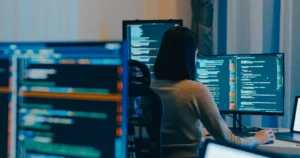Backtesting is the tool that can completely reshape the way you think about trading. Imagine having the ability to step into the past, test your strategy against actual market movements, and see how it would have performed long before you risk a single dollar in live markets. This is not a fantasy. This is the power of backtesting. By running strategies through historical data, traders gain much more than numbers on a screen. They gain clarity, confidence, and an evidence-based edge that removes guesswork from decision-making.
For beginners, backtesting acts like a safety net. It prevents the dangerous cycle of relying on hope, hype, or trading based on emotions. It allows new traders to see whether their ideas have real potential before committing money. For experienced traders, the benefits are just as powerful. Backtesting sharpens an existing edge, highlights weak points, and prepares strategies for shifting market conditions.
However, it’s important to remember that backtesting is not a magic shortcut to success. It is a disciplined process that often delivers humbling lessons. A system may look strong in theory but fail when tested against years of real data. Mistakes such as overfitting – designing a strategy that works only in past conditions but crumbles in live trading – are common traps. This is why serious traders treat backtesting not as a quick fix but as a critical step in building consistency.
In this article, we’ll walk you through the complete backtesting process. You’ll learn how to use historical data to your advantage, how to evaluate results realistically, and how to avoid the most common pitfalls. By the end, you’ll see why backtesting is not just a technical exercise but a mindset shift that separates disciplined traders from hopeful gamblers.
What Is Backtesting? Turning History Into a Trading Laboratory
Backtesting is simply the process of applying a trading strategy to past market data and measuring the results. You start with a hypothesis: a clear set of trading rules that dictate when to enter and exit trades. Then, you replay those rules over historical price movements, recording every win, loss, and drawdown. This approach turns the market’s history into your personal laboratory.
Unlike paper trading, which uses current or simulated markets, backtesting relies strictly on historical data. The advantage is that you can compress years of market action into a few days of study. For example, if you want to know how your moving average crossover strategy would have performed during the 2008 financial crisis or the 2020 COVID-19 crash, you can find out quickly through backtesting.
The value of backtesting comes not just from the results themselves, but from the lessons you learn about your system’s strengths and weaknesses. A backtest reveals more than profitability. It uncovers the risk, volatility, and psychological challenges you’d face in live trading. This honest appraisal can save you from costly mistakes later.
Historical Data Analysis: The Foundation of All Backtesting
No backtest is stronger than the data it relies on. Historical data analysis is the foundation that determines whether your results are valid or misleading. If the data you use is incomplete, inaccurate, or filled with errors, your backtesting results will be unreliable. This is why experienced traders dedicate time to sourcing clean and trustworthy data from brokers or specialised vendors before they even begin testing.
The level of detail you choose depends on your trading style. Day traders usually require tick- or minute-level data to see how strategies handle intraday volatility, while swing traders can often rely on daily charts. Long-term investors, on the other hand, may use weekly or monthly data to avoid short-term noise. Regardless of timeframe, what matters most is that the data is consistent and free of gaps, spikes, or distortions caused by holidays and technical errors.
Consider an example: if you backtest a GBP/USD strategy and later realise that one year of price history was missing due to a download issue, every performance metric becomes questionable. Profits that looked strong on paper would not hold up in real trading. This is why professionals always double-check their datasets, comparing price points with a second source and visually scanning charts after importing new files.
Cleaning and preparing data is a detailed but essential step. Correcting timestamps, removing outliers, and ensuring accuracy across your test period might feel tedious, but it is the difference between building strategies on solid ground or false hope. Traders who respect the process of historical data analysis give themselves an edge by ensuring their backtesting mirrors reality as closely as possible.
Step One: Create a Clear and Testable Trading Strategy
Your trading strategy is the blueprint you’ll test against history. The more precise and objective your rules, the more reliable your backtest will be. Every rule should be written so that anyone, or any computer program, could apply it without confusion.
Begin by stating exactly which market and time frame you’ll trade. Decide on the entry criteria: what has to happen before you enter a trade? Next, spell out your exit conditions, including both stop-loss and take-profit rules. If you use filters—such as only trading in certain market sessions or avoiding high-impact news periods—define these in detail.
For example, you might build a trend-following system on EUR/USD. You decide to buy when the price is above the 100-day moving average and the RSI reads over 60. You sell when the price falls below the moving average or the RSI drops under 50. Each rule is straightforward, allowing you to apply it to every bar of historical data without hesitation.
The discipline of writing down your strategy is itself a test. Vague rules or “gut feelings” have no place in the backtesting process. If you can’t state the rule precisely, you can’t measure its success objectively. This is where trading strategy testing demands honesty and clarity from the start.
Step Two: The Backtesting Process—Manual or Automated?
Backtesting can be done by hand or with the help of technology. Manual backtesting means loading up charts, scrolling back in time, and stepping forward one bar at a time, recording every trade as you would have taken it. This approach, while slow, gives you a deep sense of how the strategy feels in different conditions. Many discretionary and price action traders start here, learning to recognise not just the setups but also the unique behaviour of the market.
Automated backtesting, on the other hand, relies on software that applies your rules to large sets of historical data in seconds. Coding your system into platforms like MetaTrader, TradingView, or Python libraries allows for rigorous, bias-free testing. With automation, you can quickly test multiple markets, assets, or variations of your strategy.
It’s wise to begin with manual backtesting, especially if you’re new or want to understand the “personality” of your method. Once you’re confident in your rules and your logic, move to automation for broader and faster testing. Always confirm that your code or logic is faithfully executing your intended rules, as one error can skew all your results.
Step Three: Analyse the Results With Deep Historical Data Analysis
Once the trades are complete, the real learning begins. Analysing your backtest isn’t just about seeing if you made money. It’s about understanding how you made it and what risks came along the way.
Start with the win rate, but don’t stop there. Compare the average profit of a winning trade to the average loss. If your system loses more often than it wins, that’s fine if your winners are much bigger than your losers. This is why many trend-following systems have win rates below fifty percent but still generate strong profits over time.
Examine the maximum drawdown—the biggest percentage drop in your account from peak to trough. This number reveals the worst period you would have faced. Many traders give up on a system during these stretches, even if the strategy is profitable over the long haul. Understanding your system’s drawdown in advance is the key to sticking with it.
The profit factor, calculated as gross profits divided by gross losses, shows the overall edge. A profit factor above 1.5 is often considered healthy. But look beyond single metrics. Review the full equity curve. Are profits smooth, or do they come in sharp spikes and deep valleys? How long was the worst losing streak? Is the system still profitable if you increase costs or widen stops slightly? These are the questions that historical data analysis can answer.
Step Four: Watch Out for Overfitting in Trading
Overfitting in trading is the most dangerous trap for backtesters. It happens when you “tune” your system so precisely to past data that it no longer works in the future. The system seems perfect—high win rates, tiny drawdowns, and great profit factors—but only because it is tailored to the unique quirks of the test period.
This is often seen when traders try too many combinations of indicators, optimise every parameter, or endlessly tweak rules to achieve the best possible backtest performance. What looks great on a spreadsheet often collapses in live trading, when new and unpredictable market moves expose the lack of true edge.
A robust strategy works not only on the period it was designed for but also on unseen data—this is called out-of-sample testing. For example, you might develop your rules using data from 2016–2021, then test the exact same system on 2022–2023 data. If the system still performs well, it’s less likely to be overfit.
Keep your system simple. Avoid the temptation to add every filter or optimise every setting. Real markets are messy. Only those strategies with a genuine edge, not just a fit to old noise, will survive.
Step Five: Adjust for Hidden Trading Costs
A common beginner mistake is forgetting about the hidden costs of live trading. The best-looking backtest can be ruined by commissions, spreads, slippage, and overnight financing fees. These costs may seem minor on a single trade, but over hundreds or thousands of trades, they quickly add up.
If you’re trading Forex, for example, spreads can be low during normal hours but widen during volatile news or off-hours. In stocks or futures, commissions and exchange fees are unavoidable. For longer-term strategies, holding costs or swaps can drain returns.
Professional backtesting always subtracts these costs from profits as part of the analysis. Many platforms allow you to set the spread, commission, and slippage to match your broker’s real-world rates. If not, keep a spreadsheet and deduct them manually.
A backtest that looks fantastic before costs but barely breaks even after them is a warning sign. Always build your analysis on net, not gross, results.
Step Six: Forward Test Before Real Money
No matter how strong your backtest, you should always forward test your system before committing real capital. Forward testing, sometimes called paper trading or demo trading, means running your strategy in real-time market conditions. This step tests not only the logic of your system but also your ability to execute trades as planned, handle slippage, and deal with the emotional ups and downs of live trading.
For instance, if your system made money in the backtest, but you struggle to follow the rules during live conditions—or find that slippage is much worse than you modelled—it’s better to learn this lesson before risking significant capital. Forward testing helps confirm that your historical data analysis holds up when the pressure is on.
Track your trades, compare results to your backtest, and look for any unexpected challenges. Only after your strategy proves itself in live, low-risk conditions should you consider scaling up your position sizes.
Avoiding Common Risks and Pitfalls
Many traders sabotage their own efforts with small mistakes that add up. Overfitting in trading, as discussed, is a big one. But there are other subtle dangers.
If you test too many strategies or tweak too many parameters, you risk finding patterns that are pure chance. This is called data mining or “data snooping.” To avoid it, limit the number of ideas you test on the same data set, and always validate your findings with out-of-sample data.
Ignoring trading costs or using poor-quality historical data can also distort your results. Look-ahead bias—using information that would not have been available at the time of the trade—is another silent killer of reliable backtests. Always ensure your data and your rules match what would have happened in reality, not what you know with hindsight.
Lastly, avoid changing your rules mid-test. This introduces bias and reduces the value of your backtest as an objective measurement.
Using Technology: Advanced Backtesting Tools and Tips
Today’s trading platforms have made backtesting faster and more accurate than ever. Modern tools let you simulate years of trades in seconds, test multiple strategies at once, and visualise your equity curve, drawdowns, and trade statistics. Python libraries like Backtrader and platforms like MetaTrader, NinjaTrader, and Amibroker have put institutional power in the hands of retail traders.
You can now use advanced techniques such as walk-forward analysis—where you regularly update and retest your strategy on fresh data to avoid overfitting. Monte Carlo simulations can help you see how your results might change if trades occur in a different sequence, helping you prepare for unlucky streaks.
No matter your level, treat backtesting as an ongoing research process, not a one-time event. Document your tests, keep detailed notes on what works and what doesn’t, and regularly revisit your strategies as the markets evolve.
The Psychology of Backtesting: Managing Emotions and Bias
Backtesting is a numbers game, but trading is an emotional one. It’s easy to fall in love with a strategy that made money in the past and ignore the rough patches it went through. Reviewing the worst periods in your backtest—long losing streaks, deep drawdowns—will show you if you’re really prepared for what’s ahead.
Keep your analysis honest. If you find yourself constantly tweaking rules to get the “perfect” backtest, take a step back. Ask yourself if you’re chasing a real edge or just fitting in with the noise. Maintain a trading journal not just for your trades but also for your emotions and decisions. This will help you stay objective when it matters most.
Backtesting in Today’s Trading Environment: Is It Still Enough?
In an age of high-speed trading, breaking news, and global events, some traders wonder if backtesting is still relevant. The answer is yes—but it needs to be flexible. Update your strategies often, use out-of-sample tests, and don’t be afraid to pause or adjust if live results don’t match your expectations.
Schedule regular reviews and treat backtesting as a dynamic process. The lessons from history can prepare you for the future, but only if you remain a student of the market.
Real-Life Use Cases: How Traders Actually Use Backtesting
Traders at every level rely on backtesting, but how they use it varies. Algorithmic traders might use sophisticated tools to run thousands of tests on multiple markets, seeking a tiny statistical edge that can be scaled up. For them, historical data analysis is a daily routine.
Discretionary traders, who use chart patterns or price action, often backtest manually to learn which patterns are reliable and in which conditions. For example, a swing trader might discover that pin bars only work on daily charts when they appear after a strong trend, not in sideways markets.
Portfolio managers use backtesting to check how different mixes of assets—stocks, bonds, gold, or crypto—would have behaved during crises and booms. They use this knowledge to build robust portfolios that can survive shocks.
When Backtesting Fails: Real-World Stories
Even the most rigorous backtesting cannot predict the future. Markets change, regulations shift, and rare events can break any system. For example, a strategy that worked on US equities before 2020 might have failed during the COVID-19 volatility. A Forex system that ignored swap rates might look great in the backtest, only for overnight fees to erase its gains in live trading.
That’s why the backtesting process should always be combined with regular review and adaptation. Use backtesting as your guide, but never as your only tool.
Conclusion
Backtesting, at its heart, is about turning data into insight and theory into proof. By applying your trading strategy to historical data, you discover the truth about its strengths, weaknesses, and potential. Avoid the traps of overfitting in trading, always use clean data, and never ignore real-world costs. Combine rigorous backtesting with careful forward testing, and keep learning from every outcome—good or bad. With these habits, you’ll turn backtesting into your biggest trading advantage.
Read here to learn more about “Spot Trading Basics: Step-by-Step How to Profit in 2025“

I’m Chaitali Sethi — a seasoned financial writer and strategist specializing in Forex trading, market behavior, and trader psychology. With a deep understanding of global markets and economic trends, I simplify complex financial concepts into clear, actionable insights that empower traders at every level. Whether it’s dissecting winning strategies, breaking down market sentiment, or helping traders build the right mindset, my content bridges the gap between information and implementation.




